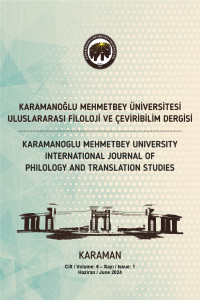Öz
Özet
Yapay zekâ son yıllarda kayda değer bir gelişme göstererek, yaşamın birçok yönünü etkisi altına almıştır. Bu alanda yaşanan ilerlemeler, makine çevirisi yoluyla çevrilen metinler üzerinde insan etkileşimini azaltan veya ortadan kaldıran bir etkiyi de beraberinde getirmiştir. Bu nedenle, yapay zekâ tabanlı çeviri yazılımları yaygın olarak kullanılmaya başlanmıştır. Bunlar arasında Google Translate, Bing, Microsoft Translator, DeepL, Reverso, Systran Translate ve Amazon Translate bulunmaktadır. Memoq, Trados, Smartcat, Lokalise, Smartling, Crowdin, TextUnited ve Memsource gibi çeşitli bilgisayar destekli çeviri (CAT) araçları da kullanılmaktadır. Son zamanlarda, araştırmacıların sordukları sorulara tıpkı bir insan gibi yanıt veren ve insan etkileşimini doğrudan taklit eden ChatGPT, ChatSonic, GPT-3 Playground, Chat GPT 4 ve YouChat gibi uygulamaların geliştirilmesinde yapay zekâdan faydalanılmıştır. Bu çalışma, insan ve yapay zekâ çevirisi arasında artık bir fark olmadığı yönündeki potansiyel hipotezi araştırmak üzere kurgulanmış olup, hukuk metinleri özelinde insan ve yapay zekâ çevirisi arasında mevcut olan farklılıkları incelemeyi amaçlamıştır. Bu doğrultuda çalışmada yapay zekânın gelişimi karşısında insan çevirmenlere olan ihtiyacın azalıp azalmayacağına ilişkin endişeler ve hukuk alanında çalışanların yalnızca makine çevirisine bağlı kalmasının mümkün olup olmayacağı incelenmiştir. Bu amaçla, çeşitli sözleşmelerden oluşan birtakım hukuk metinleri seçilerek, söz konusu metinler hem hukuki çevirmenler hem de yapay zekâ çeviri sistemleri aracılığıyla çevrilmiştir. Karşılaştırmalı bir metodolojinin kullanıldığı çalışmada, yapay zekâ ve insan çevirisi arasındaki farklar ve her iki yaklaşımın güçlü ve zayıf yönleri irdelenmiş, her bir yaklaşımın etkili olabileceği durumlar tartışılmıştır.
Anahtar Kelimeler
Yapay zekâ çeviri yazılımı makine çevirisi insan çevirisi hukuk çevirisi.
Kaynakça
- Al-Shehari, K. (2017). Collaborative learning: trainee translators tasked to translate Wikipedia entries from English into Arabic. The Interpreter and Translator Trainer, 11(4), 357-372.
- Chaudhary, S. (2023, January 4). ChatSonic review: The best ChatGPT alternative with voice commands. Retrieved 15 March 2023 from https://medium.com/@bedigisure/ChatSonic-the-best-chatgpt-alternative-2b68d048e3b.
- Choudhury, R., & McConnell, B. (2013). Translation technology landscape report. De Rijp, The Netherlands: Translation Automation Users Society (TAUS).
- Daxueconsulting. (2019, July 19). AI in hospitality in China: Are robots taking over the hotel industry? | Daxue Consulting. https://daxueconsulting.com/ai-hospitality-china/.
- Diaz, M. (2023, March 8). How to use ChatGPT: Everything you need to know. Retrieved 15 March 2023 from https://www.zdnet.com/article/how-to-use-chatgpt/.
- Federspiel, F., Mitchell, R., Asokan, A., Umana, C., & McCoy, D. (2023). Threats by artificial intelligence to human health and human existence. BMJ global health, 8(5), e010435.
- Fetzer, J.H. (1990). What is Artificial Intelligence? In: Artificial Intelligence: Its Scope and Limits. Studies in Cognitive Systems, vol 4. Springer, Dordrecht. https://doi.org/10.1007/978-94-009-1900-6_1.
- Hassan, H., Aue, A., Chen, C., Chowdhary, V., Clark, J., Federmann, C., ... & Zhou, M. (2018). Achieving human parity on automatic chinese to english news translation. arXiv preprint arXiv:1803.05567.
- Hartley, T. (2009). Technology and Translation. In The Routledge companion to translation studies, 120-141 Routledge.
- Jennifer.Murphy. (2022), February 4. How to evaluate the quality of a translation | Eriksen translations. Retrieved 15 March 2023 from https://eriksen.com/general/translation-quality-accuracy-tips/.
- Kenny, D. (2019). Machine translation. In Routledge encyclopedia of translation studies: Routledge.
- Koenig, S. P., Doganov, R. A., Schmidt, H., Castro Neto, A. H., & Özyilmaz, B. (2014). Electric field effect in ultrathin black phosphorus. Applied Physics Letters, 104(10).
- Li, B., Liu, H., Wang, Z., Jiang, Y., Xiao, T., Zhu, J., ... & Li, C. (2020). Does multi-encoder help? A case study on context-aware neural machine translation. arXiv preprint arXiv:2005.03393.
- Lih, A. (2009). The Wikipedia revolution: How a bunch of nobodies created the world's greatest encyclopedia. London, UK, and New York, NY: Aurum.
- Majumde, S., Lauly, S., Nadejde, M., Federico, M., & Dinu, G. (2022). A baseline revisited: Pushing the limits of multi-segment models for context-aware translation. arXiv preprint arXiv:2210.10906.
- Mahdy, O. S. M. M. S., Samad, S. S., & Mahdi, H. S. (2020). The attitudes of professional translators and translation students towards computer-assisted translation tools in Yemen. Journal of Language and Linguistic Studies, 16(2), 1084-1095.
- McCarthy, J. (2007). WHAT IS ARTIFICIAL INTELLIGENCE? Stanford University, 1-15. Retrieved from http://www-formal.stanford.edu/jmc/.
- Mossop, B. (2007). Revising and editing for translators, 2nd ed. Manchester: St. Jerome Publishing.
- Milmo, D. (2022, Jan 24). Mark Zuckerberg says Meta is building the world’s fastest AI supercomputer. Theguardian. https://www.theguardian.com/technology/2022/jan/24/mark-zuckerberg-says-meta-is-building-the-worlds-fastest-supercomputer
- Munro, R. (2013). Crowdsourcing and the crisis-affected community: Lessons learned and looking forward from Mission 4636. Journal of Information Retrieval, 16 (2): 210–266.
- Odacıoglu, M. C., & Kokturk, S. (2015). The effects of technology on translation students in academic translation teaching. Procedia-Social and Behavioral Sciences, 197, 1085-1094.
- O'Brien, S. (2012). Translation as human-computer interaction. Translation Spaces, 1(1): 101–122.
- O'Hagan, M. (2016). Translations Massively Open Translation: Unpacking the Relationship Between Technology and Translation in the 21st Century. International Journal of Communication, 10, 18.
- Prieto Ramos, F. (2015). Quality assurance in legal Translation: Evaluating process, competence and product in the pursuit of adequacy. International Journal for the Semiotics of Law-Revue internationale de Sémiotique juridique, 28: 11-30.
- Perez, S. (2023, March 14). Microsoft's new Bing AI chatbot arrives in the stable version of its edge web browser. Retrieved 15 March 2023 from https://techcrunch.com/2023/03/14/microsofts-new-bing-ai-chatbot-arrives-in-the-stable-version-of-its-edge-web-browser/
- Ramesh, A. N., Kambhampati, C., Monson, J. R., & Drew, P. J. (2004). Artificial intelligence in medicine. Annals of the Royal College of Surgeons of England, 86(5), 334.
- Ray, T. (2022, Feb 23). Meta's Zuckerberg: 'AI is perhaps the most important foundational technology of our time'. Zdnet.https://www.zdnet.com/article/metas-zuckerberg-ai-is-perhaps-the-most-important-foundational-technology-of-our-time/.
- Russell, S. J. (2010). Artificial intelligence a modern approach. Pearson Education, Inc.
- Yang, C. (2022, August). The Application of Artificial Intelligence in Translation Teaching. In Proceedings of the 4th International Conference on Intelligent Science and Technology, 56-60
Ayrıntılar
| Birincil Dil | Türkçe |
|---|---|
| Konular | Edebi Teori |
| Bölüm | Çeviri Makale |
| Çevirmenler | |
| Yayımlanma Tarihi | 30 Haziran 2024 |
| Gönderilme Tarihi | 2 Mayıs 2024 |
| Kabul Tarihi | 23 Haziran 2024 |
| Yayımlandığı Sayı | Yıl 2024 Cilt: 6 Sayı: 1 |
422x119
Articles published in this journal are licensed under Creative Commons Attribution 4.0 International license. This journal does not charge APCs or submission charges. Articles published in this journal are permanently free for everyone to read, download, copy, distribute, print, search and link to the full texts of these articles. |












